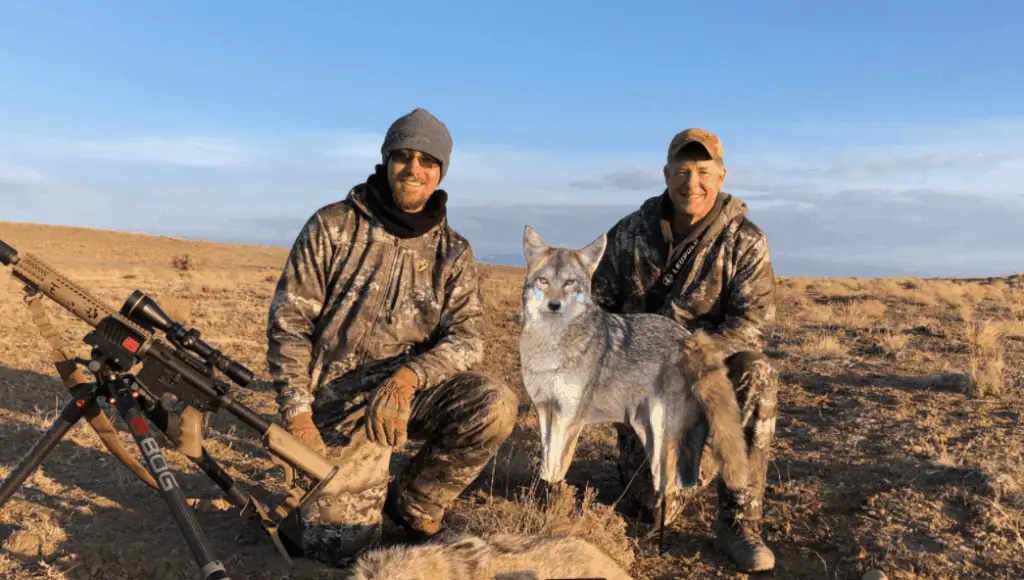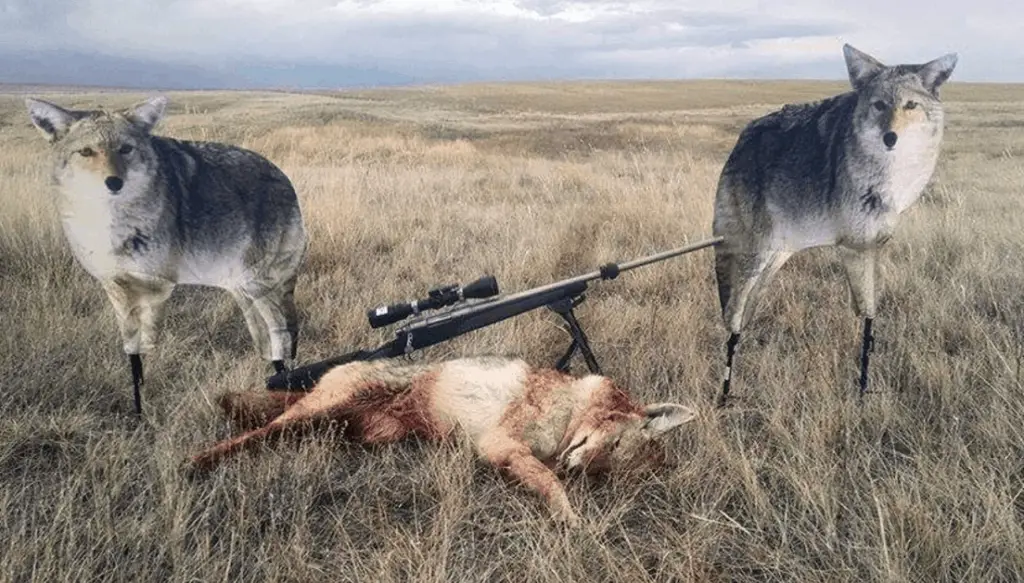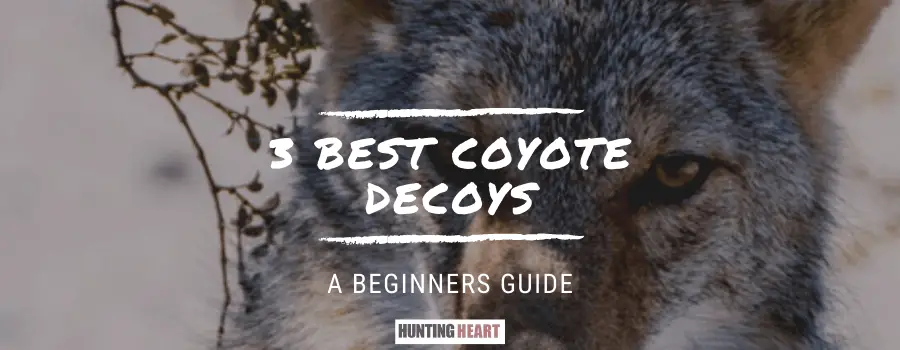As an Amazon Associate I earn from qualifying purchases.
Our Associate portal can be found here
Hunting coyotes is not for the fair-hearted. These are predator animals that are born sneaky and cunning, making them challenging to hunt. You will need every assistance you can get to match their instincts.
You will need to have camo to match the coyote’s habitat and other hunting gears to guarantee success as a hunter. A coyote decoy is a final piece to the puzzle that lures the coyote to your kill zone.
There is no one-decoy-fits-all for coyote hunters, making it challenging to find the best in the market. However, with a basic understanding of coyote traits, you can find the decoy that guarantees you instant success.
Hunting coyotes using decoys is legal, making it a useful hunting component. But using decoys can only be successful if you know when and how to use them.
Tips on How to Use Coyote Decoys
Decoys are components that mimic real animals to spark the interest of the coyotes and lure it to your kill zone. There are two kinds of decoys that you can use to hunt coyotes. These include:
- Predator decoys. Features imposter coyotes
- Prey decoys. It features animals that coyotes hunt.
How to Set up Coyote Decoy
It helps if you already know the lay of the land. Coyotes are cunning, and I have seen how they respond to coyote calls and vocalizations. For example, when they hear distress calls and don’t see the source, they get confused.
They climb to a vantage point and try to have visual confirmation. It would be best to set your decoy in an open field. Coyotes will come charging if they can associate the sound with a threat.
The following are ways you can make decoys work to your advantage when setting up your kill zone.
Location
It helps if you are familiar with the lay of the land. When using decoys, you must pick the proper locations to lure coyotes near your kill zone.
Place your decoys on an open field, as this will make you know each time a coyote takes the bait. It is characteristic of coyotes to hang out in open fields. Acquaint yourself with the open fields around your area and set up your decoys.
Timing
Coyote hunting is not legal all through the year. Know the hunting seasons and make preparations when the season opens.
The best time to use decoys for coyote hunting is between November—January. It’s the period that marks late fall and mid-winter. Using decoys is effective when the season is at its peak. The timing doesn’t include which time of the day or night to hunt coyotes.
All Clear
Coyotes are cunning and instinctively alert. For them to take the bait of your decoy, consider setting it up in their absence.
It makes more sense to ensure that no coyote is in sight if you plan to use a coyote decoy. Familiarize yourself with the surrounding and wind direction before placing your decoy in the kill zone.
Mix-it-up
Coyotes have good memories, and they rarely forget their encounters with hunters. If they have seen you once, they will not forget your face when you meet again. However, different techniques take them off their guard, and they rush into your kill zone.
You can manipulate coyote instincts to draw them out by combining different techniques with your decoy. For instance, you can make prey calls using electronic calls to lure the coyote to your decoy. (Use rabbit prey calls if your decoy is a rabbit).
A predator decoy requires that you use a howl that draws the coyote out to defend its turf. If hunting a female pup, distress calls work effectively as they instinctively rush to defend their offspring.
When To set up your coyote decoy
You can use a decoy for hunting both at night and during the day. However, when setting up, ensure that the coyotes aren’t around to see.
When setting up, ensure that the decoy doesn’t have a human odor. Coyotes have a high sense of smell and will not approach your decoy if it’s tainted with your smell. Here are some tips on how to get rid of human scent when hunting.
What are the Challenges of Using Coyote Decoys?
Portability
It depends on the model that you select. The collapsible model is compact and deflates easily, making it easy to carry around. However, bulky models are heavy to move around from one hunting site to another.
Mobility
Some designs feature injured decoys, which make them appear distressed. Other designs are rigid and won’t move at all. When working with models that have limited movements, success is reduced, and your decoy is less effective in the hunt.
Three Best Coyote Decoys Review
The market is flooded with many coyote decoys from popular brands. Each claim to have unrivaled success making it challenging to narrow down the true contenders. Here is a review of the top three coyote decoys you can buy.
1. Song Dog Coyote Decoy

If you are looking for a realistic and functional decoy, consider the Montana Song Dog coyote decoy. Coyotes are nature’s most challenging targets, and one technique may not cut it. The song dog decoy is lifelike, and coupled with a few calls; the lure always works to add realism to your hunt.
It features a slightly larger decoy with a lifelike tail that mimics real movement from the slightest wind contact. The new Song Dog decoy has new printings and can fold easily so that you can carry it around hassle-free.
The 2D decoy folds to a perfect 9X9 square making it easy to pick up once you are done with your hunting. It’s unlike other 3D decoy critters and relies on a good print to deceive a real coyote.
However, it has motorized movements of the tail, noises, and fur shell. Because the tail can move even from the slightest wind movement, it means curious coyotes can fall for the trap and enter your kill zone.
Pros
- High-resolution 2D picture
- Movement of the tail from the slightest wind contact
- It folds to a perfect 9×9 square for easy transportation.
- Easy to use
Cons
- It depends on the wind to make any movements
- It doesn’t include speakers to make coyote sounds
- Not 3D means a coyote can come from a different side and hence spook instead of getting attracted.
2. Kojo Coyote Decoy

Kojo coyote decoy is among the few decoys that border on realism. If you want to grab a coyote’s attention and hold it in place to take a shot, you should try the Kojo. Even though it’s still a 2D decoy, it features an original picture of a coyote.
You will find that it serves more than one purpose, depending on your intent. For instance, you can use it to keep wild geese and deer off your garden.
The Kojo decoy is best used together with a coyote call. Calls can make a coyote curious, but it’s not enough to lure them into a kill zone. But when they see the Kojo decoy, they react instinctively to defend their turf.
Despite it not being 3D like other coyote decoys in the market, the 2D print is so convincing that you can mistake it for a real coyote at a distance when you stake it. Another advantage of this model is that it’s lightweight, and you can move it around easily.
At only 16—ounces inclusive of the stakes, it is among the lightest under review. The poles are pointy at the end so that it breaks the soil easily when setting up. It doesn’t feature a complicated setup, hence suitable for beginners.
It’s a two-sided decoy hence no blind spot that can spook a real coyote coming from whichever side. When folded, the Kojo coyote decoy is only 10x10x2—inches. You will find this portable and compact to fit in a backpack.
The overall weight is under a pound.
Pros
- Compact when folded. Only 10x10x2—inches
- Easy to transport from one hunting site to another
- Lifelike color and size that make coyotes rush to your kill zone.
- Other uses include goose and deer repellant on gardens, parks, and lakes.
- It weighs under a pound, hence easy to transport.
- It doesn’t require a battery—only slight wind movements to bring its tail to life.
- Easy to set up and use.
- Durable and sturdy to serve you for a long time if stored properly after every use.
Cons
- It’s a 2D print and not convincing enough from certain angles.
3. Miss Hoptober—Montana Predator Decoy

This coyote hunting decoy falls under the most simplistic predator decoy you can use to hunt coyotes. While other decoys feature motorized components, this one uses a cloth, wire, and picture of a rabbit.
The design includes stuffing in the shape of a rabbit and attaching a photo on one side of the bag. The wire runs inside the bag and comes out the other end to act as stakes.
It doesn’t have any motorized parts meaning that it can’t make remote-controlled movements. However, when you are a few yards away, it looks like a real cotton rabbit.
Transportation is easy as it folds to 10×5—inches and only 17×9—inches when open. It’s lightweight and easy to set up.
Pros
- Features a simple design without any motorized parts
- Ease of use and set up.
- Low cost
- No batteries necessary
Cons
- Static. It means it has no movement
- No waterproof design is available at the moment.
How to Make a DIY Coyote Decoy
Making a coyote decoy is a straightforward process. You can make the most by following these few steps.
- Print two 2D pictures of a full-body coyote
- Stick the two images on a wireframe to cover both sides
- Attach the images on supporting stakes and drill to the ground.
- You can have speakers to make electronic coyote calls
- You can follow the same process for making a predator decoy.
How to Make a DIY Rabbit Decoy
- Stuff some old clothes in a bag the size of a rabbit.
- Run a stake through the bag and secure it firmly in place using a rope.
- Print a 2D image of an alert cottontail rabbit and attach it to: both sides.
- Your decoy is now ready to use. Stake it to the ground and wait for coyotes to come.
Conclusion
Coyotes are not always aggressive, and a decoy will not make them charge blindly. However, a realistic imposter may draw it away as it appeals to its curious instincts.
The perfect decoy placement is an open field where you and the coyote can have a clear sighting of the decoy. Ensure that you are against the wind direction so that the coyote doesn’t catch your scent as it approaches the kill zone.
The perfect coyote decoy features different intents and purposes. You can combine decoys with coyote calls to draw maximum attention.
Amazon and the Amazon logo are trademarks of Amazon.com, Inc, or its affiliates.

36 years old, been hunting and fishing my entire life – love the outdoors, family, and all kinds of hunting and fishing! I have spent thousands of hours hunting hogs and training hunting dogs, but I’m always learning new stuff and really happy to be sharing them with you! hit me up with an email in the contact form if you have any questions.



